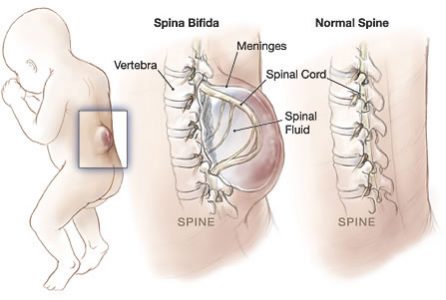Spina bifida is the incomplete formation of the spine and spinal cord that occurs during the first month of a baby’s development in the womb. It is a common form of neural tube defect (NTD). The defect affects people differently, some have minimal effects, others have severe multiple effects.
People with spina bifida have varying degrees of permanent disability including paralysis or weakness in the legs, bowel and bladder incontinence, hydrocephalus and specific learning difficulties. However, many are able to lead full, active and independent lives.
Hydrocephalus is a build-up of cerebrospinal fluid around the brain. About 80-90% of people with spina bifida have hydrocephalus and therefore have a ‘shunt’. This is a plastic tube that drains the excess fluid from their brain to their heart or abdomen. It is important to identify the position of the shunt and take care not to displace it when lifting or transferring the person. Shunts can become clogged or malfunction and must be replaced if this happens. Look for symptoms of headaches, vomiting, lethargy, irritability, swelling, redness along the shunt tract, or changes in personality or behaviour. Clogging or malfunction can also result in seizures.
Programming Considerations
- Loss of sensation can result in the inability to notice changes in pressure, temperature or friction that can lead to accidental bruises or burns (ie: water temperature, hot concrete).
- Generally the individual will have some type of urinary appliance such as a catheter so proper care needs to be taken.
- Often a colostomy bag is worn, and this should be emptied every three to four hours and before physical activity.
- As individuals may be in a wheelchair or have mobility issues, extra time may be required to compete activities and daily living tasks.
- The individual may need 1:1 support, so make allowances for this in staffing numbers if necessary
Strategies for Inclusion
- Do not assume what a person can and cannot do – ask the individual if they need assistance and help only with those things they request.
- The amount of assistance will vary with each individual.
- Individuals may be in a wheelchair so physical activities may need to be modified to include them in the group.
Behaviour Management Issues
The malfunction of a shunt may result in drowsiness, irritability, vomiting, and dizziness and will require medical attention.
(Source – Spina Bifida Victoria)
Further information: www.sbfv.org.au

